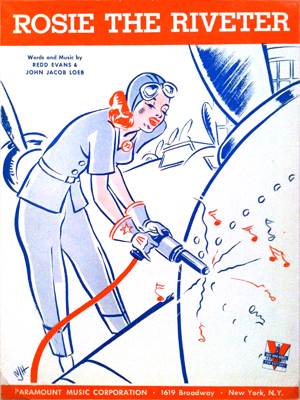 “See You For Dinner” (ca 1943?)
“See You For Dinner” (ca 1943?)
artist unknown
18 x 27 in., acrylic on board
Coppola Collection
There is just no telling where and for what purpose this partially completed painting was made.
The intended era is clearly WW2, featuring a woman with many of the features of the iconic “Rosie the Riveter” from a painting by Norman Rockwell, published as the cover to The Saturday Evening Post on May 20, 1943 (see below for reference).
The other stuff I bought with this is all WW2 era editorial cartoon art, so it is likely that this is contemporary to those, but it could have been done years later for some reflective purpose.
The intent is clear: a delightful “other side of the story” on Rosie’s life. Her strength is being applied every day to the war effort while the aproned Mr Riveter is at home, tending to the household chores.
For the record, you might have encountered the “We Can Do It!” image as Rosie (see below), but that association came 40 years later.
The “We Can Do It!” image is from an in-house 1942 motivational work campaign at Westinghouse, meant to inspire production workers of both sexes to work harder. It was not a public image and was on display at Westinghouse for only two weeks in February (early in the war, just two months after Pearl Harbor). The image was not associated with women’s roles in heavy manufacturing labor.
The origins of “Rosie the Riveter” and the associated representation for the women who famously joined the workforce during WW2 date to a popular song of the same name (c. 1942, and released and recorded in early 1943). Depictions of women in coveralls with short sleeves and their hair in bandanas were commonly represented on the sheet music for the song (see below).
While other girls attend their fav’rite
cocktail bar
Sipping Martinis, munching caviar
There’s a girl who’s really putting
them to shame
Rosie is her name
All the day long whether rain or shine
She’s a part of the assembly line
She’s making history,
working for victory
Rosie the Riveter
Keeps a sharp lookout for sabotage
Sitting up there on the fuselage
That little frail can do more than a
male will do
Rosie the Riveter
In the song, Rosie’s boyfriend is a marine, so the association with this painting does not appear to be literal. By the time Rockwell paints the Post cover, in mid-1943, the look for Rosie the Riveter had been established and people would have known at a glance what and who they were looking at.
The Rockwell painting was reproduced widely, and used during a War Bond campaign. After the war, the image faded from view.
In the 1980s, the “We Can Do It!” image was rediscovered and used in conjunction with a women’s empowerment message. At some point, the image became strongly attributed as the Rosie the Riveter, in part, it is speculated, because of the copyright issues surrounding reproduction of the Rockwell painting.
At any rate, the “We Can Do It!” image has been widely used over the last 40 years and is often labeled as Rosie, including its availability on souvenir items – from shirts to shot glasses – that you can buy from the museum shop at the Smithsonian and at the National WW2 Museum in New Orleans (which is an awesome museum, by the way).

Normal Rockwell’s Rosie the Riveter cover to The Post (May 20, 1943)
 The “We Can Do It!” poster from the 1942 in-house Westinghouse campaign
The “We Can Do It!” poster from the 1942 in-house Westinghouse campaign

Cover to the 1942 Sheet Music

